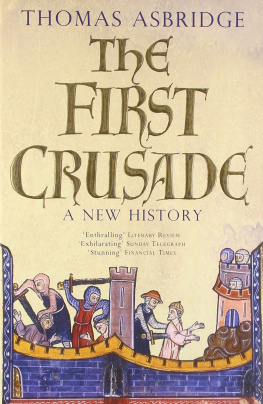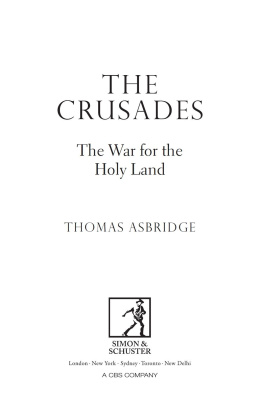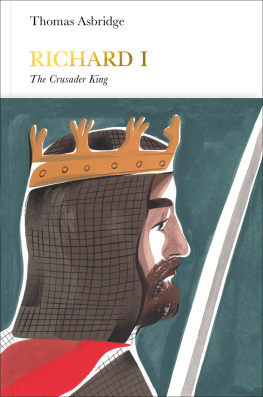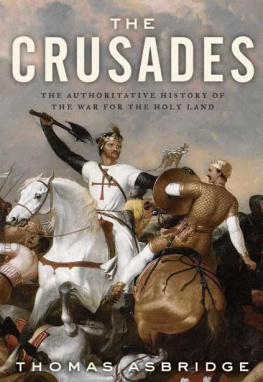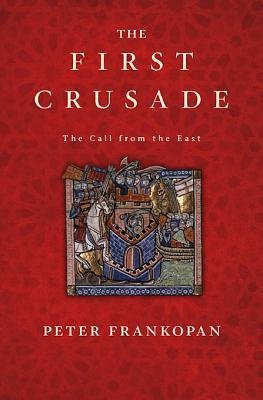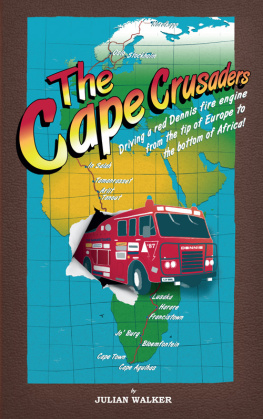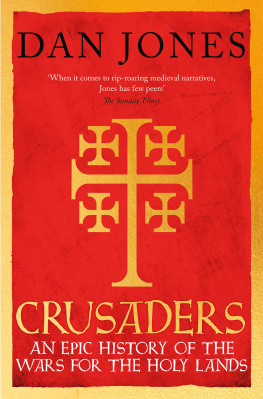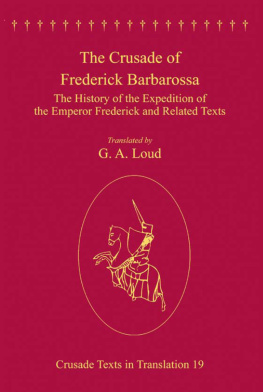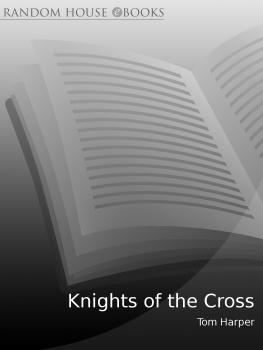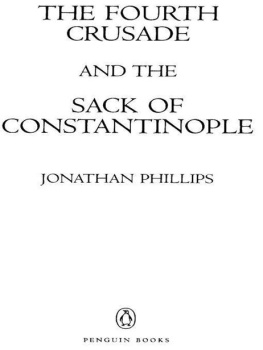A CIP catalogue for this book is available from the British Library.
ISBN: 0-7432-2084-6
Typeset by M Rules Printed and bound in Great Britain by Cox & Wyman Ltd, Reading, Berks
PICTURE CREDITS pp. 1, 8,15,21: British Library pp. 7,11, 22: Susan B. Edgington pp. 3,4,12,14: Bibliotheque Nationale de France pp. 5, 9, 30: Agence Photographique de la Reunion des Musees Nationaux pp. 6,13: The Walters Art Museum, Baltimore pp. 2,10: The Art Archive pp. 16,17,18,19, 23, 24, 25, 26, 27, 29: Thomas Asbridge p. 20: AKG-images p. 28: Hulton Getty
FOR CHRISTINE AND ELLA
CONTENTS
Preface xi
List of Maps xv
Cast of Characters xvii
HOLY WAR PROCLAIMED l
AFIRE WITH CRUSADING FEVER
THE JOURNEY TO BYZANTIUM
THE FIRST STORM OF WAR
BEFORE THE WALLS OF ANTIOCH
TIGHTENING THE SCREW
TO THE EDGE OF ANNIHILATION
DESCENT INTO DISCORD
THE FALTERING PATH
THE HOLY CITY
AFTERMATH
Conclusion
Glossary Chronology
Notes
Bibliography
Index
PREFACE
The First Crusade stands as one of the most remarkable episodes in European history. It saw tens of thousands of people embark on an extraordinary 3,000-kilometre journey to the Holy Land, their aim to recapture Jerusalem from Islam in the name of the Christian God. Facing bone-crunching exhaustion, deadly disease, wretched starvation and bloodthirsty battle, these crusaders demonstrated a capacity for intense religious devotion as well as appalling brutality. Against all odds and at dreadful cost in terms of human suffering, they prevailed. The events of the crusade were so dramatic, its impact so colossal as to inspire countless generations, across nine centuries, to grapple with its history. All have struggled to comprehend such a powerful and disturbing event. Most have assumed that Europe was driven to crusade by some form of pre-existing genetic hatred for Islam, and that a desperate clash between these two civilisations was all but inevitable. In the modern era, analysis of the First Crusade has been drawn in other directions. In its various incarnations over the last 150 years, the expedition has been all but stripped of its devotional context to become little more than a grand but greedy raid, presented as the first glorious flowering of western colonialism and exposed as conclusive evidence of medieval Europe's spectacular barbarity.
In recent decades the intense efforts of historians in Europe, the Near East and North America have honed and reshaped our understanding of the crusade's origins, progres s and impact. But, to date, no scholar has drawn together these strands of research to present a new analytical narrative of the expedition, accessible to a wide audience. This book will not attempt to present the definitive history of the First Crusade; such a feat would be all but impossible. Drawing upon cutting-edge scholarship, original research and an intimate knowledge of the Levant, it will shed new light upon the expedition's inception, explaining what motivated such a multitude of Europeans to join the crusade; it will retell the story of its participants' incredible journey, asking how a venture devoid of centralised leadership and seemingly prosecuted with little or no forward planning avoided immediate annihilation; and it will assess the true nature of relations between Christendom and Islam at the time of the crusade and demonstrate how they were transformed by the attack on the Holy Land.
I began writing this book three years ago, but it is really the product of a far more enduring passion for crusading history. I was first introduced to the wondrous tale of the First Crusade by the inspirational teaching of Richard Mole. Even then, at the age of sixteen, I was captivated and soon decided that I wanted to devote my life to the study of the crusades. Now, nearly two decades later, I count myself very lucky to have found my way into academic life and a career as a medieval historian.
Along the way I have been helped by many friends and mentors, but I would here like to express my particular thanks to those who, in one way or another, have shaped my approach to this book. Peter Edbury, Professor of Medieval History at the University of Cardiff, and Jonathan Riley-Smith, now Dixie-Professor of Ecclesiastical History at Emmanuel College, Cambridge, guided me through university life as an undergraduate and postgraduate, teaching me the principles of historical research and the value of critical analysis. It is my sincere hope that they will not judge this, my first attempt to bring the medieval world alive for a wider audience, too harshly.
Thanks are also due to a number of other crusade scholars, most notably to Professor Malcolm Barber and Dr Susan Edgington for reading drafts of this book and proffering valuable advice, and to Dr Jonathan Phillips for his continued friendship and encouragement. I am indebted to many of my colleagues in the Department of History at Queen Mary, University of London, not least for the provision of research leave in which to complete this book. Without the advice of Professor Peter Hennessy I might never even have begun, and the feet that my sanity survived the actual process of writing relatively intact owes much to the treasured friendship of Dr James Ellison and Kathryn Mallen.
My work also benefited enormously from the patient faith of Andrew Gordon, my editor at Simon & Schuster. The finished text of the book owes much to his warm encouragement and astute editorial judgement
I would also like to thank the staff of the Institute of Historical Research, London, where much of this book was written, and the Department of History at the University of Reading for providing a generous travel grant to enable me to walk 350 miles along the route of the First Crusade from Antioch to Jerusalem in the summer of 1999. My experiences during that journey, alongside my other varied travels in the Levant, provided invaluable background for the book.
I have been lucky enough, through all my academic career, to benefit from the unerring support of my family. This book has been no exception, but I must express a special vote of thanks to my parents for demonstrating immense forbearance during the rather tortured last months of writing as I sought to complete the text and adjust to the wonderful but exhausting duties of fatherhood.
I wish to give my deepest, most heartfelt thanks to my wife, Christine. Through long months and years of writing and research she has stood by my side, offering unflinching support, acting as a sounding board for my ideas and providing the most constructive criticism of this work. Above all, she brought the miracle that is our daughter Ella into the world and held all our lives together as I finished this book.
Just before this book was completed, my agent, Giles Gordon, died after a sudden accident. Without Giles' sage guidance I would never have had the opportunity to bring my vision of the First Crusade to a mainstream audience. I will always regret that he was not able to read this book in its final form, but I hope he would have approved. I will miss him very much.

